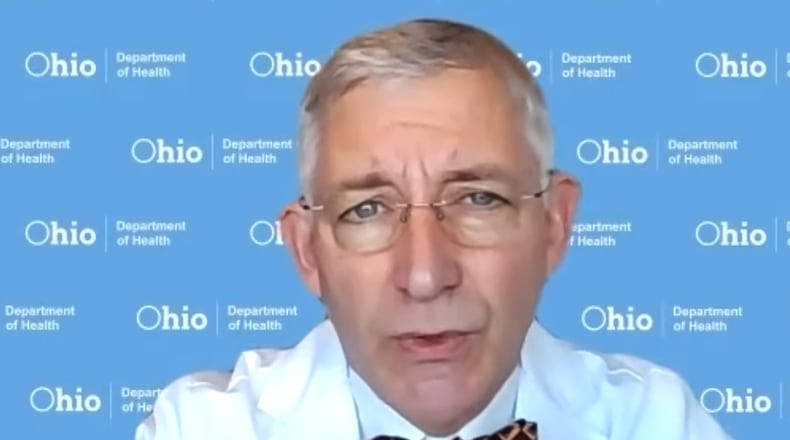“We all need to do our part to mitigate a severe outbreak after the holidays,” Vanderhoff said.
RSV and the flu hit Ohioans earlier and harder than in pre-pandemic years, but those tracking hospitalizations are saying they are beginning to decline. The Centers for Disease Control says RSV hospitalizations have fallen by two-thirds over the past month. The rate of infection remains high, but it is not near the peak the state experienced in mid-November, Vanderhoff said.
“RSV, which primarily affects young children, as well as some of our more vulnerable adults, had a very early and rapid rise this fall,” Vanderhoff said. “Thankfully, over the past few weeks, we’ve seen RSV begin to decline, both here in Ohio and nationally.”
CDC and statewide surveillance have also seen flu hospitalizations drop, but Vanderhoff said it is unlikely that flu cases will drop quickly to a low number.
“More likely, we’re looking at a situation where we could see sustained high levels with peaks and valleys for a number of weeks. That kind of sustained high plateau, perhaps with small peaks and valleys, is pretty typical of influenza,” Vanderhoff said.
Cases of COVID-19 have seen moderate increases in recent weeks in Ohio. Immunity provided by COVID-19 vaccines appear to be helping evade severe illnesses, Vanderhoff said.
“We’re just not seeing the kinds of peaks in cases or hospitalizations that we’ve seen with the arrival of other new dominant variants in the past. Looking at COVID-19 hospitalizations by this time in mid-December of 2020 and 2021, Ohio was experiencing anywhere from 2,000 to 3,000 people hospitalized every week. This year, the numbers are about 600 a week. So that’s at least a 70% improvement from the past two December’s so there’s certainly good some good news here,” Vanderhoff said.
Large holiday gatherings still pose a risk of spreading illnesses, though, so health officials have recommended getting vaccinated against COVID-19 and the flu, staying home when sick, and wearing a mask if an individual is sick and unable to stay home.
“Most importantly, if you’re not feeling well or somebody in your family or close circle is not feeling well, stay home, isolate yourself,” said Dr. Joe Gastaldo, medical director of infectious diseases at OhioHealth. “If you’re not feeling well, you know if you have a respiratory virus, we don’t want to go into work. You have to be very cognizant of you spreading viruses to other individuals. I know in the real world, people sometimes do have to leave the house if they’re not feeling well with the respiratory virus symptom. And in that situation, I would strongly recommend people wear a high quality mask if you have to leave the house.”
Individuals should also be cognizant of whether or not they live in a county with a high level of COVID-19 community spread. All counties in the Dayton region are at a medium, according to the CDC. Should that spread increase to a high level of spread, the CDC recommends wearing a mask indoors regardless of vaccination status.
“You should be following that recommendation if it comes to that. There are some counties in the state of Ohio who do have high community level of COVID. In the most scenarios, regardless of vaccination status, the recommendation is to wear a mask. If you’re not feeling well, wear a mask,” Gastaldo said.
Air ventilation is also important, Gastaldo said, as circulating air can help move viruses out of the air you’re breathing.
Gastaldo also recommended wearing a face mask or taking a rapid COVID test before attending a large gathering where there may be individuals who are vulnerable to illnesses.
State health officials also recommend having a plan in place for getting tested for COVID-19 in case symptoms start to occur. Antiviral treatments like Paxlovid must be taken with five days of the onset of symptoms to help treat COVID-19. Tamiflu, an antiviral treatment for the flu, must be taken within two days of the onset of flu symptoms to help prevent severe illness. Those are immunocompromised or at risk of developing a severe illness from the flu can also take Tamiflu as a preventative tool if they become exposed to the flu, Gastaldo said.
“For example, if your grandma is 80 years old or someone is elderly in your family, if they’ve had an exposure to somebody with confirmed influenza, that’s really a reason for that person to take Tamiflu once a day preventatively,” Gastaldo said.
For both COVID-19 and the flu, Gastaldo recommended those at risk of severe illness to talk to their doctors and have a plan in place should they test positive for those illnesses.
About the Author


